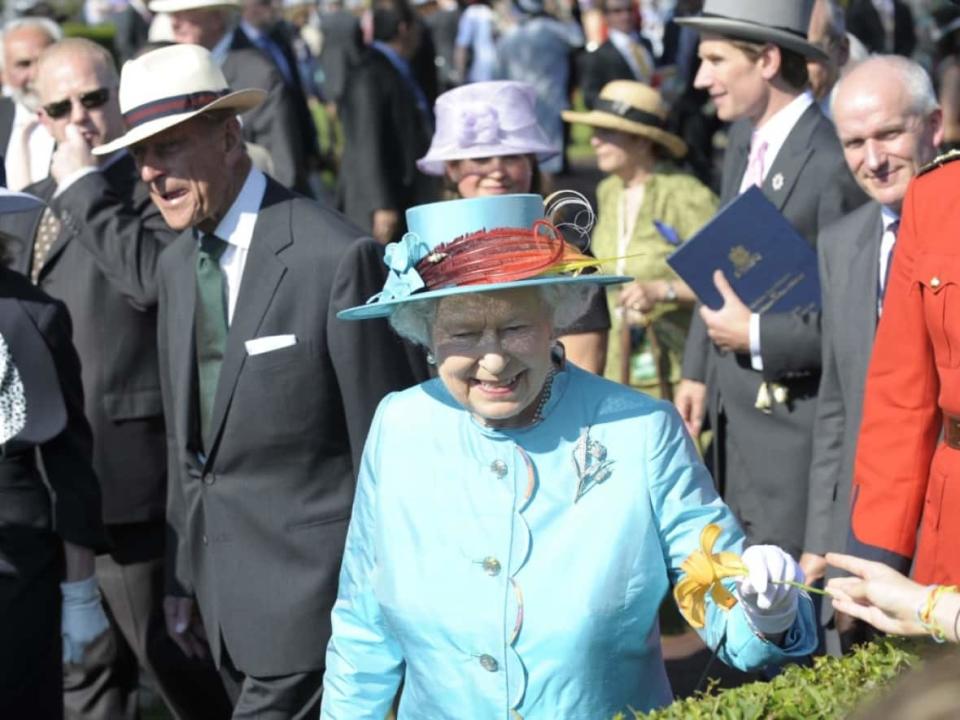Queen Elizabeth took her horse racing seriously when she attended Queen's Plate

There are certainly worse people to be cornered by at a social reception than Queen Elizabeth II.
But there Jim Lawson was, in a small boardroom at Toronto's Woodbine racetrack, hours before the 2010 running of the Queen's Plate horse race.
"She knew that our family had a horse in the race that day and she pulled me aside — and I will never forget this — she wanted to talk about horse breeding and she wanted to know my family's history in the sport," recalled Lawson, now the CEO at Woodbine.
Lawson remembers preparing for weeks ahead of the Queen's visit, versing himself in royal protocols for what he thought would be a fleeting greeting. But in a room full of dignitaries the Queen sought him out, eager to pick his brain on the intricacies of breeding and pedigree.
"She probably had an audience of 35 or 40 people in the room and I awkwardly monopolized her, but it wasn't my doing," he said Thursday after news of the British monarch's death.
It was a 15-minute conversation Lawson said he's thought of often over years.
"Her level of knowledge about horse breeding was at a level that shocked me, and we were talking about North American breeding, not Irish or English breeding," Lawson said. "It was remarkable and her intellectual curiosity about breeding was off the charts."
WATCH | Queen Elizabeth II, Prince Philip make 1st and final visits to the Queen's Plate:
Lawson said the Queen had clearly done her research and knew all about Lawson's family's horse, Ghost Fleet, which was slated to run that day. She was particularly interested in its connection to Northern Dancer, one of the greatest Canadian racehorses and a prodigious sire.
"She said, 'tell me about the horse in the race and I understand that he comes from a fine lineage,'" Lawson said. "It was all about the race and what did I think of his chances and what were my thoughts about the horses in the race. She was very much focused on the race."
The 2010 race marked the fourth and final time Queen Elizabeth attended the Queen's Plate, but she maintained a strong connection to the longest-running stakes race in North America.
At the conclusion of the race each year, Lawson said he would read a telegram that would be sent to the Queen advising her of who won the race and its breeding lineage. And each year Buckingham Palace still sends a bank note drawn on the Buckingham Palace treasury for 50 guineas, the original prize money Queen Victoria awarded to the winner of the first race back in 1860.
"She was very, very proud of that legacy, that relationship between the monarchy and Canada and, more narrowly, Woodbine," Lawson said.
Queen Elizabeth's lifelong passion for horse racing and breeding is well documented. Over a span of more than 70 years, the monarch put hundreds of horses in the winner's circle.
"I enjoy breeding a horse that is faster than other people's," she told the BBC in 1974. "To me, that is a gamble from a long way back. I enjoy going racing but I suppose, basically, I love horses, and the thoroughbred epitomizes a really good horse to me."
Lawson said the Queen's deep connection and interest in her horses ran far deeper than simply a hobby.
"I hear that when she got up in the morning,the first thing she'd reach for was the British equivalent of the Daily Racing Form, the racing program, to see what was going on with her horses," Lawson said with a smile.
WATCH | Queen Elizabeth's famous Canadian sports moments:
In 2016, the Queen sent a horse named Dartmouth to race at Woodbine. Dartmouth was accompanied by the Queen's longtime horse manager, John Warren. Lawson said the following year was a big anniversary for the Queen's Plate and he asked Warren if he thought there was any way the Queen or somebody from Buckingham Palace might attend.
Lawson was stunned at what happened next.
"He says, 'let's call her, it's no problem, I call her all of the time. In fact, she's waiting up to watch the race online, to see how Dartmouth runs,'" Lawson remembered. "It was just such an amusing moment … the fact that she'd be up at around 11 o'clock at night London time to see how her horse ran in the Canadian International."
Dartmouth finished second, by the way.
It was one of numerous horses the Queen ran at Woodbine over the years, the last one being a filly named Magnetic Charm in 2019.
Lawson said the Queen's death will ultimately mean changes to the race's name but, out of respect, that's a discussion he will have with the board next week.The race began as the Queen's Plate under Queen Victoria, but changed to the King's Plate between 1901 and 1952 during the reigns of Edward VII and VIII, and Georges V and VI.
"She was a good person for our sport and because she was so influential and her love of racing was so obvious throughout the world and she'll be missed in that regard," Lawson said. "She'll obviously be missed as the great person she was and such a kind and genuine person, but the sport of horse racing will dearly miss her."

 Yahoo Sports
Yahoo Sports 
